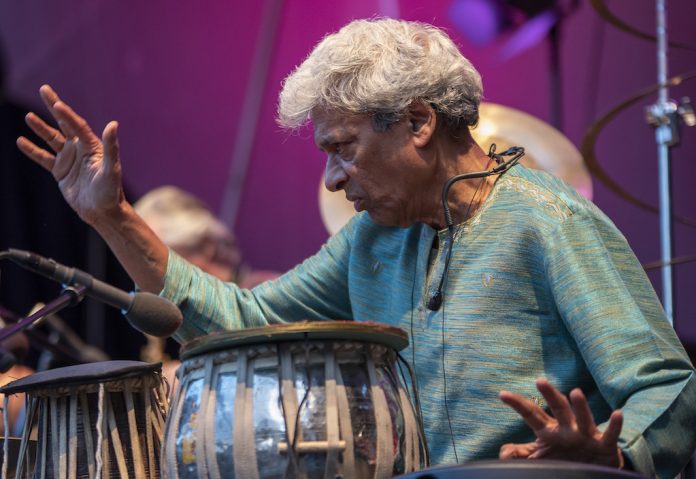
Making a welcome return to the London Jazz Festival, Norwegian sax legend Jan Garbarek led his international quartet of virtuosi for a spectacular two-hour concert at London’s Royal Festival Hall.
Garbarek’s last appearance in London featured the saxophonist with the Hilliard Ensemble performing two sell-out gigs for the LJF in 2014 at Temple Church. But this year’s concert was his first in London since November 2016, playing with a conventional jazz line-up, again for the LJF. But this group’s sound was a million miles away from the liturgically oriented Officium recordings. Garbarek’s association, collectively and severally, with the members of his jazz group spans decades.
Gurtu is also a truly fantastic drummer and in effect is a one man Indo-Jazz fusion … It’s his ability to switch instantly from Eastern to Western modes that is so amazing and his jazz drumming is staggeringly dexterous and powerful
He played on Indian percussionist Trilok Gurtu’s album Living Magic (CMP, 1990) some 30 years ago and the German pianist and keyboardist Rainer Brüninghaus has accompanied the saxophonist since Legend Of The Seven Dreams (ECM, 1988). Newer member of the group is Brazilian bass guitarist Yuri Daniel who’s been with Garbarek for over a decade now.
But strangely it was not Garbarek who dominated this non-stop performance. Granted there were old favourites, as heard on the group’s last major double CD Dresden (ECM, 2009), such as Milagre Dos Peixes. He also played a folky piece on a selje (willow) flute in a duet with Gurtu, in a similar vein to his rendition of the tune Nu Bein (again on Dresden). Garbarek, looking suave and sprightly for his 72 years, in jeans and checked shirt, like a hip college lecturer, alternated between his trademark curved soprano and tenor saxophones. But the real meat of the evening derived from standout solos from Brüninghaus, Daniel and in particular Trilok Gurtu, who stole the show.
Whilst the lugubrious-looking pianist executed a coruscating acoustic piano solo (the Steinway might well have needed some TLC afterwards) similar to but even more tumultuous than the Dresden one (Transformations), Daniel’s hands flew around his five-string fretless bass guitar. His solo commenced with an impressive version of Mongo Santamaría’s Afro Blue, gradually evolving into a display of lightning-paced thumb slapping and plucking.
Gurtu was simply outstanding. He delivered part of the set seated on that remarkably effective percussion box known as a cajón and also performed a short konnakol vocal solo. His first percussion solo proper was a tour de force of virtuosity but his second lengthier solo involved a huge array of percussion instruments including – perhaps a first in any musical context – a bucket full of water used to create extraordinary sounds by immersing instruments, such as a gong, into it and later actually playing the bucket’s side like a drum so water began to spurt out, fountain-like.
Gurtu is also a truly fantastic drummer and in effect is a one man Indo-Jazz fusion. His kit comprised both Western traps and cymbals but also an array of Eastern percussion including tablas and other Indian drums. It’s his ability to switch instantly from Eastern to Western modes that is so amazing and his jazz drumming is staggeringly dexterous and powerful.
There were, oddly, no announcements or introductions from Garbarek of any kind and the repertoire was delivered seamlessly, often taking the audience by surprise as there was sometimes difficulty in distinguishing between numbers that mostly segued together. At the close of the 120-minute marathon the band received a rapturous standing ovation from the capacity audience and the encore was a beguiling version of Blind Faith’s Had To Cry Today. Garbarek still has the ability to mesmerise an audience but his secret weapon here was undoubtedly Gurtu, the fabulous master percussionist.
Jan Garbarek Group feat. Trilok Gurtu, Royal Festival Hall, London, 17 November 2019 as part of the EFG London Jazz Festival















